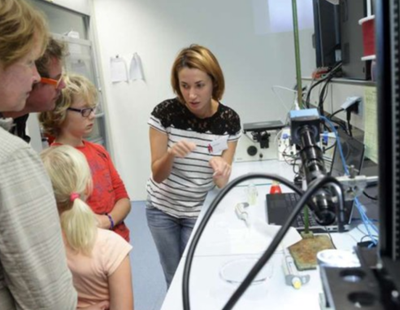Catalytically induced flows - increasing productivity by activity contrast
Aura Visan is a PhD student in the Soft Matter, Fluidics and Interfaces Group. Her supervisor is prof.dr.ir. R.G.H. Lammertink from the Faculty of Science and Technology.
 As presented in the last century in chemical engineering textbooks, there has been a general consent on the diffusion based mass transport inside porous catalysts. As pressure driven flows are forbidden at this small dimensions, convective transport seems to be out of the question. The famous Ernest Thiele pointed out that pellets of excellent catalyst are active only at the surface, given the underlying assumption that diffusion is the only replenishment mechanism inside the catalytic pores.
As presented in the last century in chemical engineering textbooks, there has been a general consent on the diffusion based mass transport inside porous catalysts. As pressure driven flows are forbidden at this small dimensions, convective transport seems to be out of the question. The famous Ernest Thiele pointed out that pellets of excellent catalyst are active only at the surface, given the underlying assumption that diffusion is the only replenishment mechanism inside the catalytic pores.
In this thesis we challenge the generally accepted narrative on mass transport for heterogeneous catalysis and demonstrate that convective transport inside catalytic dead-end pores is not only possible, but ubiquitous for higher kinetics. Surface flows induced by concentration gradients, i.e. diffusio-osmotic flows, form during catalysis inside the pores. This additional mass transport does not require any external input. It spontaneously arises when the configuration of the catalyst matrix facilitates the development of significant gradients with respect to the bulk solution. The reaction driven surface flow which originates in the osmotic pressure gradient and diffusion potential in case of charged species, replenishes the catalytic pores with fresh solution, having a positive impact on the conversion. We visualise and quantify the flow in 3D using the General Defocusing Particle Tracking technique. We analyse the phenomena using a model that includes the fluid dynamics actuated by the concentration gradients that arise due to the catalytic reaction. We are able to extract parameters revealing the interaction strength between the reactant/product chemical species and the catalytic surface.
Diffusion is also the dominating mass transport mechanism close to the catalyst surface where external mixing loses its efficiency. We introduce the concept of enhancing external transport by patterning catalysts. The reactivity contrast designed by alternating active and inactive regions generates spontaneously in-plane gradients that drive a steady diffusio-osmotic flow. While the details of the numerical model may need to be adjusted for particular catalytic reactions, the approach is not pinned to a certain chemistry. Concentration gradients will develop as long as kinetics are fast enough to place the system in the mass transfer limiting regime. The diffusio-osmotic flow is redirected out of plane due to the symmetry of the system and mixes the otherwise diffusion dominated boundary layer which greatly enhances mass transport and thus impacts the overall conversion. Scaling laws provide a direct correlation between the catalytic chemistry, the dynamics of the system, and the conversion enhancement. Specific chemistries, with known reaction kinetics and interaction potentials, can now be tested against this predictive model.
Slurry reactors are known for their high conversion capacity as they benefit from high mass transfer rates. This has been explained so far by accessible high catalytic surface areas and small diffusion length scales. In this thesis we demonstrate experimentally an overlooked transport mechanism by which particles migrate towards higher reactant concentration. Whenever an uneven particle distribution appears, the higher particle density region will lower the reactant concentration more than the surrounding environment. This macroscopic concentration gradient propels the particles towards higher reactant concentration by diffusio-osmotic flows. We believe this phenomenon to be present for arbitrary chemical conversions whenever their kinetics are fast enough to preserve significant concentration gradients. We have analysed the experimental particle distribution by means of a numerical model that includes diffusio-phoretic movement of the catalytic particles. While the phenomenon is general, the particle migration signature is specific to the catalytic system, depending on kinetics and molecular interactions between the reactant/product species and the catalyst surface.





